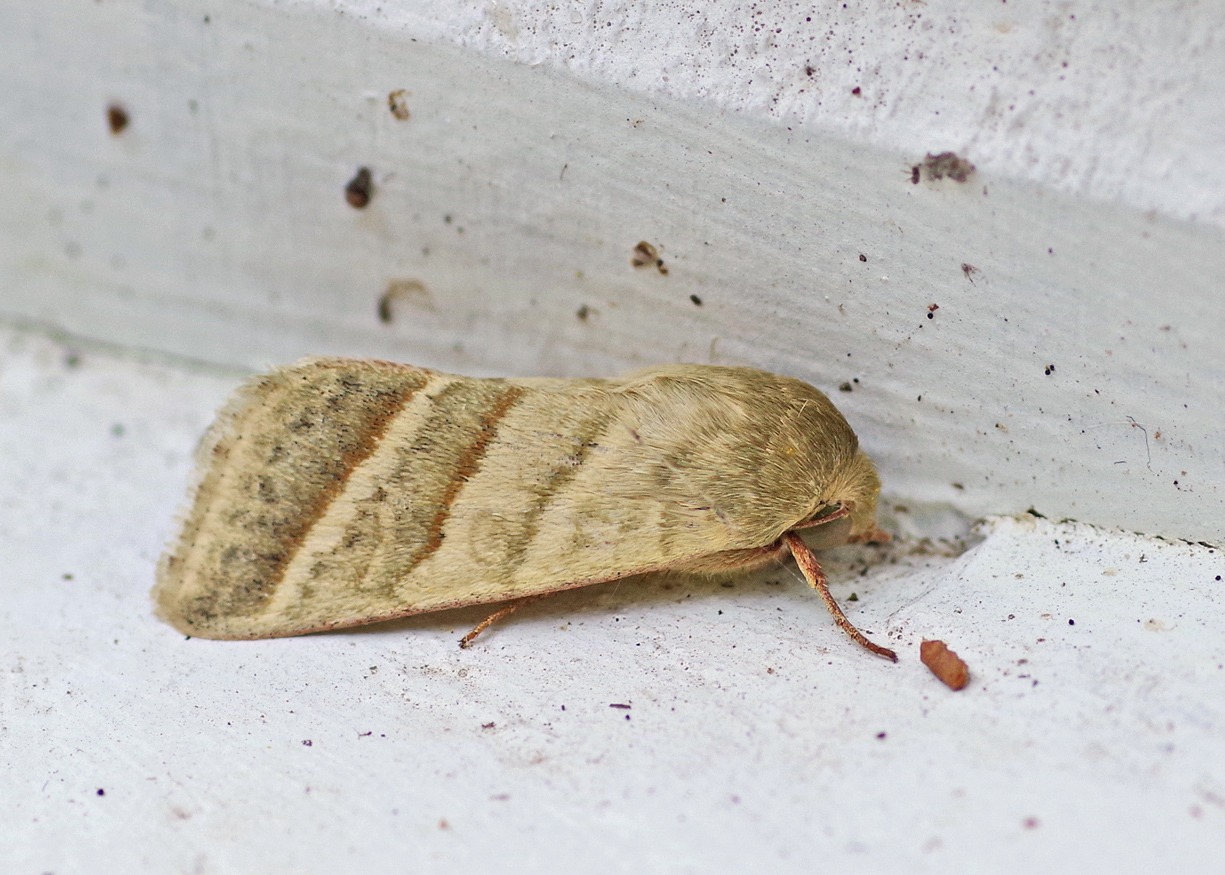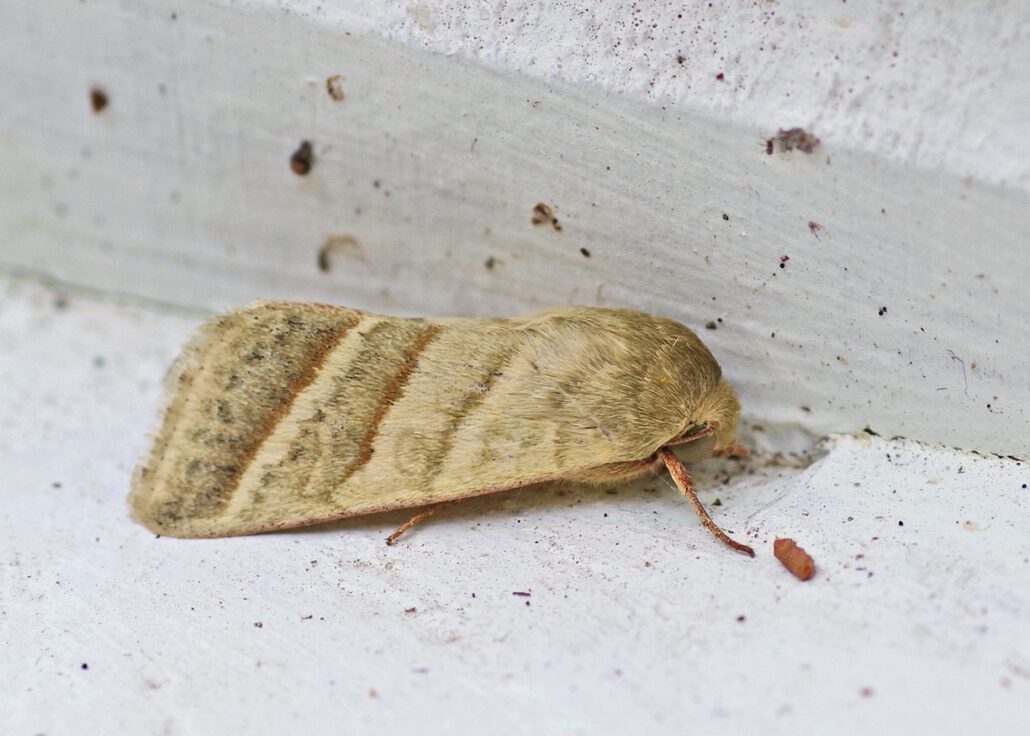
by Kate Redmond
Tobacco Budworm
Greetings, BugFans,
The BugLady photographed this handsome moth on her back porch rail last summer, and she was temporarily mystified when she identified it as a Tobacco budworm moth, because the nearest tobacco farm is probably more than 100 miles west of her. Then she found an alternative common name – the Geranium budworm – and since she is the Geranium Queen, it made more sense (and it explained the frass on the bookshelves).
There are lots of moths that aren’t big enough or bad enough or beautiful enough to have been studied enough. This isn’t one of them. It gets University Extension Agents riled up throughout tobacco and cotton-growing areas in the southern half of its range.
Tobacco budworms (Chloridea virescens) (before 2013 they were Heliothis virescens) are native moths in the Owlet moth family Noctuidae. They’re considered an eastern and southwestern species, but they’ve been spotted in Canada, across the vast majority of the lower 48 plus the Caribbean, and sporadically south of the Rio Grande. They produce five or six broods annually in the South, but generally just one or two in the North, and they are too tender to overwinter here. Moths seen in the northern parts of the US in the second half of summer may have overwintered in a greenhouse or a sheltered patio or in a potted plant that was brought inside in fall, or they may have drifted north from the southern part of their range.

Adults have a wingspread of about one-to one-and-a-half inches and are somewhat variable in color. Virescens means “being or becoming green” and while some are greenish https://bugguide.net/node/view/662023/bgimage, many Tobacco budworm moths are tan https://bugguide.net/node/view/1440535/bgimage. The caterpillars’ color is also variable and, as David Wagner says in Caterpillars of Eastern North America, “Somehow the larvae end up matching the color of their foodplant. The caterpillars found on red geraniums are shades of pink, those on ground cherry yellow, and so on.” https://bugguide.net/node/view/1735907/bgimage (pink flowers make pink frass https://bugguide.net/node/view/32268/bgimage), https://bugguide.net/node/view/899588/bgimage, https://bugguide.net/node/view/36749/bgimage.
The first generation of larvae chew deeply into buds (scroll down https://extension.umn.edu/yard-and-garden-insects/tobacco-budworms) and the later broods feed on the flowers and seeds. They prefer the reproductive tissues, but they’ll also eat leaves, leaf petioles and even stems, and the later generations cause the most damage to plants. No picky eaters here – these are generalist feeders! They especially like tobacco and cotton, but they eat other agricultural crops like soybeans, flax, squash, tomato, peanuts, peppers, lettuce, and alfalfa and other clovers,. Garden flowers like roses, geraniums, morning glory, petunias, nicotiana, chrysanthemums, marigolds, snapdragons, zinnias, and verbenas are on the menu, and, as the bulletins say, so are “weeds” like beardtongue, cranesbill/wild geranium, dock, lupine, passion flower, ground cherry, and more (“weeds” – so judgy). They’re not considered a pest here in God’s Country.
They are eaten by a variety of insects and spiders, but where some of their predators are concerned, the caterpillars seem to have Super Powers. According to Wikipedia, if a parasitic wasp named Cardiochiles nigripes approaches a caterpillar with the intention of laying an egg on it, a fluid oozes from the caterpillar’s pores “that causes C. nigriceps to become agitated and groom themselves, allowing the budworm to escape. C. nigriceps also avoid budworms painted with this exudate. It is hypothesized that this exudate may function by overloading the wasp’s sensory receptors.” The tachinid fly Winthemia rufopicta may be successful at laying eggs on the exterior of a tobacco budworm caterpillar, “but upon hatching and trying to penetrate its host, the caterpillars react by biting, crushing, puncturing, or trying to eat the parasitoid eggs. This kills off many of the maggots” (Wikipedia). Plus (says Wagner) “My colleague Scott Smedley and his students recently discovered that the caterpillars manage to transfer the glandular defensive secretions of their foodplants onto their own setae [hairs], and in doing so accrue chemical protection from ants and other natural enemies.”
They court with pheromones – she releases chemicals (perfumes) into the air, but she will not produce them unless she has been in contact with a potential host plant, and a place to lay her eggs is assured. He reads her signals with receptors on his antennae and responds, and when she picks up his signal, she stops producing hers. Males court with pheromones produced by glands in structures called hair pencils, which pop out of their abdomen. The chemicals he produces are “twofers” – they send a “back-off” message to other males, and a “come hither” message to females. If she approves of his scent, it’s “game on.” The odor has both a stimulating and tranquilizing effect on her.
She lays her eggs https://bugguide.net/node/view/699644/bgimage (usually 300 to 500 of them, but as many as 1,500) on buds, blossoms and leaves in the upper parts of plants. Research suggests that she picks as a host the same species of plant that she grew up on. The larvae hatch and, if they’re not already there, head for the tips of the plant. Larvae grow faster at warmer temperatures, and when they are mature, they pupate a few inches under the soil https://bugguide.net/node/view/587565/bgimage.
Two big photo references – one to Wisconsin moths https://www.butterflyidentification.org/moths-by-state-listing.php?reach=Wisconsin, and the other a giant collection of caterpillar pictures by wildlife photographer Tom Murray (Wisconsin shares many moth species with New York) https://pbase.com/tmurray74/moth_caterpillars.
Kate Redmond, The BugLady
Bug of the Week archives:
http://uwm.edu/field-station/category/bug-of-the-week/
